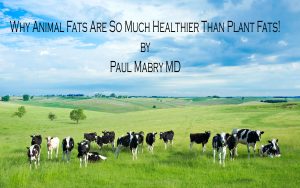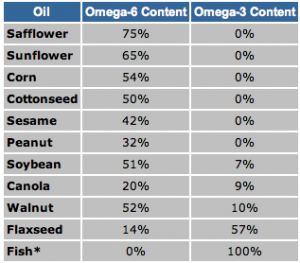 One of the reasons that I choose to eat a diet consisting primarily of animal products is because it is the best way to get one of the most health giving nutrients that our bodies need but cannot make for themselves, Omega-3 fatty acids. Most experts say we need at least 500-600 mg per day of Omega-3 fatty acids. The reason that I believe a plant based diet is a much inferior way of obtaining the omega-3 fatty acids that we need is because the human body can only use 2 types of omega-3 fatty acids, EPA and DHA. Neither of these forms of Omega-3 fatty acids are found in any plant.
One of the reasons that I choose to eat a diet consisting primarily of animal products is because it is the best way to get one of the most health giving nutrients that our bodies need but cannot make for themselves, Omega-3 fatty acids. Most experts say we need at least 500-600 mg per day of Omega-3 fatty acids. The reason that I believe a plant based diet is a much inferior way of obtaining the omega-3 fatty acids that we need is because the human body can only use 2 types of omega-3 fatty acids, EPA and DHA. Neither of these forms of Omega-3 fatty acids are found in any plant.
ALA is the most common plant form of omega-3 fatty acid. Our bodies cannot use ALA and must first convert it to EPA then DHA. The problem is that we are only able to convert about 10% of the ALA that we ingest from plants successfully meaning that only 10% of the Omega-3 content of the plants foods that we eat count toward our daily need of 600 mg. And ingesting a lot of Omega-6 fatty acid at the same time as plant omega-3 fatty acids, can decrease this conversion of the plant omega-3 fatty acids to the useable EPA and DHA by 40% as this article shows. Plants tend to be higher in omega-6 fatty acids than animal products. The plant derived “Seed Oils” like soybean oil, canola oil and corn oil are markedly higher in omega-6 fatty acids.
 A decrease in the risk of heart disease has been seen on diets high in omega-3, especially fatty fish which contains large amounts of both EPA and DHA. That may be through an anti-inflammatory effect on heart arteries, here is a study on human placentas that shows the exact pathways through which DHA exerts its anti-inflammatory activity in our arteries. If you have already had a heart attack, omega-3’s can help you not to have another one as this study shows.
A decrease in the risk of heart disease has been seen on diets high in omega-3, especially fatty fish which contains large amounts of both EPA and DHA. That may be through an anti-inflammatory effect on heart arteries, here is a study on human placentas that shows the exact pathways through which DHA exerts its anti-inflammatory activity in our arteries. If you have already had a heart attack, omega-3’s can help you not to have another one as this study shows.
DHA is essential for growth and maintenance of a healthy brain. Here’s a quote from this scientific article on the subject. “DHA is the predominant structural fatty acid in the central nervous system and retina and its availability is crucial for brain development.” It is particularly important in the growth and development of the brain from fetus to young adulthood, a period when the brain is growing rapidly. This is a link to numerous studies documenting how important adequate DHA intake in the diet is for pregnant mothers and infants through young adulthood.
 DHA is also essential for the health of the brain in the elderly. Dr. Perlmutter in one of his blogs discusses a study in depth that measured the patient’s DHA reserves by measuring the amount of DHA in red blood cells. The researchers then did MRI’s of the subject’s brains along with cognitive testing. Here’s a quote on what they found. “Those individuals having the lowest levels of DHA had significantly lower total brain volume as well as significantly greater levels of small strokes in their brains compared to individuals with higher levels of DHA. Beyond these findings, those with the lowest levels of DHA performed worse on tests of both visual memory and executive function as well as on tests designed to evaluate abstract thinking.”
DHA is also essential for the health of the brain in the elderly. Dr. Perlmutter in one of his blogs discusses a study in depth that measured the patient’s DHA reserves by measuring the amount of DHA in red blood cells. The researchers then did MRI’s of the subject’s brains along with cognitive testing. Here’s a quote on what they found. “Those individuals having the lowest levels of DHA had significantly lower total brain volume as well as significantly greater levels of small strokes in their brains compared to individuals with higher levels of DHA. Beyond these findings, those with the lowest levels of DHA performed worse on tests of both visual memory and executive function as well as on tests designed to evaluate abstract thinking.”
Inflammation is a large component of many diseases including asthma, allergies, arthritis, migraine headaches and on and on. DHA has been shown to decrease inflammation by down modulating the COX2 arm of the Arachidonic Acid pathway that produces most of the inflammation causing chemicals in our bodies as this study shows.
Inflammation is the biggest problem with the high Omega-6 levels in seed oils. Inflammation is an underlying cause of the following disease. Just click on the disease for information on why.
among many other conditions.
For people with diabetes and pre-diabetics DHA can help with their insulin resistance and chronic inflammation. There is a DHA receptor on cells for, “Mediating Potent Anti-inflammatory and Insulin-Sensitizing Effects” according to this study.
 Our evolutionary ancestors ate Omega-6 and Omega-3 fatty acids in a ratio close to 1 to 1. Since the onset of agriculture and the switch to a plant based diet some 12,000 years ago the ratio of omega-6 to omega-3 fatty acid intake by humans has crept up to around 16:1. These high ratios have been associated with a host of inflammatory conditions including cardiovascular disease, cancer, inflammatory and autoimmune diseases as discussed in this study.
Our evolutionary ancestors ate Omega-6 and Omega-3 fatty acids in a ratio close to 1 to 1. Since the onset of agriculture and the switch to a plant based diet some 12,000 years ago the ratio of omega-6 to omega-3 fatty acid intake by humans has crept up to around 16:1. These high ratios have been associated with a host of inflammatory conditions including cardiovascular disease, cancer, inflammatory and autoimmune diseases as discussed in this study.
One study showed that lowering the ratio to 4:1 could cut the risk of heart disease by 70%.
There are clearly health benefits to be gained by eating more Omega-3 fatty acids and less Omega-6. The best places to get healthy omega-3’s is fish or meat. For example 100 grams of Salmon contains 339 mg of Omega-6 and 3982 mg of Omega-3 for a ratio of 0.1:1 (AWESOME!). Beef is another good source. 100 grams of ribeye steak contains 510 mg of Omega-6 and 240 mg of Omega-3 for a ratio of 2:1 (YEAH!)
 On the other hand, as you can see from the this table, Seed Oils are very high in unhealthy Omega-6’s and very low in Omega-3’s. The only rich plant source, Flax Seed Oil has the form of Omega-3 that our bodies cannot use. Our bodies can only convert about 10% of this plant form of omega-3 into DHA, so Flax Seed Oil is not nearly as healthy as it looks. All Omega-3’s from animal sources come in the form of DHA or EPA which we are able to use.
On the other hand, as you can see from the this table, Seed Oils are very high in unhealthy Omega-6’s and very low in Omega-3’s. The only rich plant source, Flax Seed Oil has the form of Omega-3 that our bodies cannot use. Our bodies can only convert about 10% of this plant form of omega-3 into DHA, so Flax Seed Oil is not nearly as healthy as it looks. All Omega-3’s from animal sources come in the form of DHA or EPA which we are able to use.
Finally I try to maximize my DHA intake as because I value my intellectual function very highly. I think maximizing my DHA intake is the best way to preserve it into my later years. Here’s how I personally do this.
 I generally have three eggs a day fried in butter. The eggs I use contain 225 mg omega-3 each. That gives me 675 mg of omega-3 right there.They are available in most good stores. I have seen eggs advertised with as much as 660 mg of Omega-3 per egg. Thanks to a response from a reader, I need to add that the chickens used to produce “omega-3” eggs can be fed very different things to achieve this. Some are fed fish oil or fish powder and the omega-3 they produce is DHA. Some however are fed flax seed. An article I found says that these eggs contain ” One omega-3 egg typically contains 340 milligrams of ALA and 75 to 100 milligrams of DHA.” This is still better than a regular egg that only has 35-50 mg of DHA. Still I would recommend you investigate to find out what the chickens are being fed for the brands of “Omega-3 Eggs” available to you and pick the DHA fed chicken eggs if possible. The ounce of butter my eggs are fried in has another 100 mg of omega-3. I eat 3-6 ounces of cheddar cheese a day at 90 mg omega 3 per ounce. Most of the meat I eat is in the form of hot dogs and sausage which contain extra fat which helps me avoid getting too much protein in my diet but the extra animal fat also contains extra Omega-3’s. For example Oscar Meyer all beef franks have 67 mg of omega-3 per ounce and I have at least 9 ounces of sausage or hot dogs a day. So I’m sure I’m averaging around 1650 mg of omega-3 per day. No need to supplement.
I generally have three eggs a day fried in butter. The eggs I use contain 225 mg omega-3 each. That gives me 675 mg of omega-3 right there.They are available in most good stores. I have seen eggs advertised with as much as 660 mg of Omega-3 per egg. Thanks to a response from a reader, I need to add that the chickens used to produce “omega-3” eggs can be fed very different things to achieve this. Some are fed fish oil or fish powder and the omega-3 they produce is DHA. Some however are fed flax seed. An article I found says that these eggs contain ” One omega-3 egg typically contains 340 milligrams of ALA and 75 to 100 milligrams of DHA.” This is still better than a regular egg that only has 35-50 mg of DHA. Still I would recommend you investigate to find out what the chickens are being fed for the brands of “Omega-3 Eggs” available to you and pick the DHA fed chicken eggs if possible. The ounce of butter my eggs are fried in has another 100 mg of omega-3. I eat 3-6 ounces of cheddar cheese a day at 90 mg omega 3 per ounce. Most of the meat I eat is in the form of hot dogs and sausage which contain extra fat which helps me avoid getting too much protein in my diet but the extra animal fat also contains extra Omega-3’s. For example Oscar Meyer all beef franks have 67 mg of omega-3 per ounce and I have at least 9 ounces of sausage or hot dogs a day. So I’m sure I’m averaging around 1650 mg of omega-3 per day. No need to supplement.
What? Hot dogs and sausages? Why not some grass fed beef and Kerrygold butter if you need more fat? I think that would be a little more nutritious.
I was asked why I preferred hot dogs and sausages over grass fed beef and Kerrygold butter. Certainly grass fed beef is higher in omega-3 fatty acids and lower in omega-6 fatty acids than the feedlot beef my hotdogs and sausages are made from. I personally was a sugar and carbohydrate addict for 62 years before I found low carb. In that time I managed to damage my endocrine system badly enough to develop fairly severe insulin resistance. It is my experience that though highly insulin resistant people like myself can often lose some weight and decrease their blood sugar levels and hemoglobin A1c readings somewhat on a low carb, high fat diet that does not restrict protein, they are unable to achieve an ideal body weight or hemoglobin A1c unless they also limit protein to less than 1.5 grams per kilogram of ideal body weight per day, and preferably no more than 1 gram/kg/day. I also believe that high protein diets are unhealthy though fairly well tolerated by people with minimal insulin resistance for 2 other reasons. First the protein that a person eats in excess of what his body needs for building and repair of cells is simply turned into sugar in the liver by the process known as gluconeogenesis. The body has no mechanism to “store” extra protein. This sugar from the excess protein is either burned or turned into fat and stored. This additional sugar can trigger the release of additional insulin and high insulin states are the cause of insulin resistance and promote inflammation in the body. Second, there is good evidence for the theory that excess protein in the diet stimulates the mTOR pathway which causes cells not to undertake needed repairs and replacement of damaged components and ultimately “die and early death”. Life extension through protein restriction and drugs which inhibit the mTOR pathway have been shown in flat worms and mice. Of course this does not prove that this is the case for humans but there is a lot of evidence that suggests this may be the case and little evidence to show that it is not. I’m am currently hedging my bets in this direction. The leading proponent of the theory is Dr. Ron Rosedale a physician and low carb researcher for over 30 years. You can hear his thoughts in this lecture. https://www.youtube.com/watch?v=Yv-M-5-s9B0&t=19s&list=PLUYVL4FeyiCJjErDtOuwfXOBIzrZEtHRp&index=50
Now how does all that relate to the question? Well, when considering what you want to eat, there are always thousands and if we really wanted to get technical maybe millions of trade-offs that have to be considered including nutritional content, anti-nutrient content, price, availability, reliability of supplier and on and on. When considering both grass fed beef and Kerrygold Butter, here are my personal thoughts. My personal philosophy is that for someone eating an all meat diet the macronutrient (protein, carbohydrates and fat) content of your diet is 1000 times more important than the micronutrient (vitamins, minerals and essential fatty acids) content. I believe that whether one eats meat from cows who never received hormone injections or antibiotics and ate only organically grown grass all their life or cows that ate grass in a Texas or New Mexico field when it was growing and hay during the winter for 21 months then were taken to a feed lot where they ate a mixture of hay, grains and animal protein to “fatten them up” for 3 months before being slaughtered (like the ones I eat), I’m still going to get all the nutrition my body needs to function healthfully. Yes the grass fed cow is going to give 100-200 more mg of DHA a day than the Feed lot beef I eat, but I’m already getting 3 times the required amount of DHA in my diet. Yes, I would get 100-200 mg less Omega-6 but that’s only going to change the ratio a little and as I’ve shown from nutrition data a feedlot rib-eye has a great omega-6 to omega-3 ratio of 2:1, I’ll bet the grass fed cow would only be around 1.5:1 not that significant a difference. The drawback to the grass fed cow for me is the fact that the meat of grass fed cows is always leaner. Than means every ounce of meat has less fat and more potentially damaging protein for the reasons mentioned above. I rarely eat steak any more because of this. I eat either 27% fat hamburger or all beef sausages which have not only healthy offal meat in them often but have the healthy, DHA filled fat that the butchers trim off so they don’t offend fat fearing customers. And none of the Sausage I buy has more than 4.25 grams of protein per ounce, some are as low as 3 grams of protein per ounce and all taste delicious. Grass feed beef is usually around 7-8 grams of protein per ounce so to meet my protein limitation goals I wouldn’t be able to eat very much at all and might still be hungry afterward.
In my experience most dairy cows are grass fed when possible. I don’t see how Irish Cows could be eating anything but hay in the winter unless there’s something you know about Ireland that I don’t (I’ve never been there). I did live in Watertown, NY for 3 years when I was stationed at Ft. Drum. I met several of the many dairy farmers around there and their cows ate grass in the field all day. If you have stats showing the difference in omega-3 acid content between Land O Lakes Butter and Kerrygold, I’d love to see it. Till then I plan to buy whatever butter is 100% butter with the lowest price (I eat a lot of it).
What about Brazil nuts and other raw nuts?
Nuts are seeds. Their oils are seed oils and in general are very high in Omega-6, pro-inflammatory fatty acids and low in Omega-3. I research most of my data on http://www.nutritiondata.com which uses the USDA data base. Here’s their data for 1 ounce of Brazil Nuts: Total Omega-6 fatty acids 5758 mg, Total Omega-3 fatty acids 5.0 mg, giving us a ratio of 1150:1, very unhealthy. All seeds and nuts are also very high in Phytates which markedly interfere with our ability to absorb many minerals I will be addressing this in detail in my next blog post this week: “Anti-nutrients Found in Plant”.
Great article, Paul!!
Thanks. Planning to do “Anti-nutrients found in plants” next.
Unfortunately, the eggs your are eating do not contain mucy EPA or DHA … the omega 3 is mostly linoleic acid … the same omega 3 found in the flaxseed they are consuming. One omega-3 egg typically contains 340 milligrams of ALA and 75 to 100 milligrams of DHA. One brand I know of has all DHA omega-3 because they use algae with DHA in their feed. That brand is Gold Circle Farms and they are hard to get. I know this because I used to work for both the egg industry and the Flax Council of Canada and introduced the entire industry to the potential of Omega 3 in the 1990s.
Wow, great intel. I’ll have to revise the blog and add this. Thank you. Wish I could find “Gold Circle” eggs. Still 100 mg is better than most plant sources which are few and far between.
Only COLD BLOODED fish that live in 30 degree Arctic seawater need high intakes of omega-3 which they use as an antifreeze to keep their tissues from freezing up solid. Omega-3’s are natures most powerful blood thinner, in WARM BLOODED humans that live at 98.6 degrees on the surface in the sunlight and in heated homes and can wear clothes, high intakes of omega-3’s thin human blood out too much cause bruising, bleeding and can cause hemorrhagic stroke and also makes cell membranes too fluid, unstable and leaky.
http://khanada2.tripod.com/efa-analysis.pdf
http://brianpeskin.com/pdf/reports/OptimumPEOratio-CAMB.pdf
I aggree with all your facts but not your conclusion. Yes fish who live in subzero water have much higher levels of omega-3 but even fish who live in tropical waters are relatively high in omega-3 fatty acids compared to land dwelling animals. You are right that omega-3 fatty acids decrease the tendency of blood to clot slightly through 2 different mechanisms. First they bind to platelets and decrease the tendency of platelets in the blood to stick together, the first step in forming a blood clot. Second they act hormonally in the liver where most of our blood clotting chemical chain is manufactured telling the liver not to make as many of the factors that help blood clot and to make more of the factors that make blood thinner. What you didn’t mention is that omega-6 fatty acids also act hormonally in the liver sending it the exact opposite message from omega-3 fatty acids. Omega-6 fatty acids induce increased clotting factor production in the liver and thicken the blood. Having thick blood is much more dangerous than thin blood. The triggering event for most strokes and heart attack is the formation of a clot that blocks blood flow, either to the brain or to the heart muscle. One clotting problem that often affects young people, in the prime of life, especially pregnant women is a condition called a “Deep Venous Thrombosis (DVT)”. There is stagnation of the blood in the large veins in the calf, often after prolonged sitting, leading to clot formation if the blood is too thick. This can be very painful but it can also be lethal if the clot breaks off and is carried to the lungs blocking the pulmonary artery. This is called a “Pulmonary Embolism”. I can think of 5 patients in my 26 years of medical practice who died this way. I also have never heard of a case of bleeding complications in someone taking omega-3 supplementation (I personally do not recommend taking any supplements of any kind). So the question comes down again to the Omega-6 to Omega-3 ratio. Is it pushing your blood toward being too thick or too thin. If you’re eating a lot of plant fats there’s a good chance you’re being pushed toward being too thick which puts you at risk of coagulation related diseases like heart attack, stroke and DVT.
Any comments on coconut oil?
If one were going to use a plant oils in their diet , my picks as the healthiest would be first Macadamia Nut Oil with an Omega acid ratio of 6:1, and 3/4ths of the total fat monounsaturated, it almost makes me want to eat plants again. Still Animal oils can match this and they’re not loaded with phytates like this seed oil which I will be addressing my my next blog post on Plant Anti-Nutrients. (PS Nutritiondata did not have a separate entry for Macademia nut oil oil so I used 1 ounce of nuts to calculate to oil ratios). Coconut Oil comes in second because it is 90% saturated fatty acids with tons of medium chain fatty acids which the body can convert directly to ketones without any intermediate transformations making coconut oil a rich source of healthy ketones to feed the brain. Coconut oil however contains no Omega-3’s and thus a ratio cannot be calculated but it has very little Omega-6 also, an ounce has just 520 mg. So from that standpoint they’re ok by me. They are not a “seed oil” they are a “fruit oil” like Avocado and thus don’t have the phytate issue but they do contain large amounts of salicylates which can interfere with the Arachadonic Acid and COX2 pathways which I will address in my next post on Plant Anti-Nutrients. Further down my list comes Olive Oil, another “fruit oil”. In it’s favor it is 2/3rd healthy monounsaturated fatty acid. To its discredit it has an Omega Ratio of 13:1 (not good) and an ounce contains 2734 mg of Omega-6 fatty acid over 5 times as much as an ounce of Coconut oil but of course nowhere near the Omega-6 content of most seed oils. One reason that I personally would never consider using olive oil is that over 80% of the olive oil sold in stores has be adulterated with cheap seed oils like soy and canola to increase profits and there is no way to tell by smell or visually. Here is an article about that. http://www.foodrenegade.com/your-extravirgin-olive-oil-fake/ Avocado Oil appears to be another relatively healthy “fruit oil”. It is 2/3rds monounsaturated, but does have a 13:1 Omega acid ratio and each ounce contains 3509 mg of Omega-6 fatty acid, a gram more than Olive Oil. and finally I would list Palm oil, another “fruit oil” worthy of consideration. It’s claim to fame is being over 1/3 monounsaturated and 1/2 saturated fat. Great for a plant oil. The Omega acid ratio is not up to animal oil standards at 13:1 and it carries 2548 mg of Omega 6 per ounce. From here, to my knowledge plant oils continue to get worse and worse with less saturated and monounsaturated fats, higher omega acid ratios and higher contents of Omega-6 fatty acid. All the data is from Nutritiondata.com who gets their info from the FDA. Please feel free to double check me. I used the 1 oz serving size for all calculations. There are many ways to eat a healthy diet. My opinion is that it is harder to do eating plant materials but I can’t prove that any better than the people who think the opposite can conclusively prove their arguments. I enjoy questions and challenges like this one that stimulate new avenues to research.
Fascinating article! Thanks so much for posting and working through all this! Could this be why I lost weight then gained again on ZC? I’m ZC for 20 months, eat mostly steak and bacon, occasionally fast food burgers. Tried hamburger for awhile and it didn’t seem to satisfy and I felt a little “anxious/twitchy”. In the first 8-9 months, I dropped 35 pounds, then last fall started slowly gaining again. I added 25 pounds. I don’t obsess about the weight, as I truly believe I must be healing from years of insulin issues. But, also not sure that 3-4 pounds of meat per day is what is ultimately needed in my case. Am I getting too much protein and not enough fat?
In my opinion CJ, the all the meat you want, eat at least 2 lbs per day approach to Zero Carb works great for maybe 60-70% of the people who try Zero Carb, but at least 30% of the people who try this form of ZC from the feedback I’ve seen on the various ZC blogs either stall their weight loss after a small loss or some even gain weight. I was in the Stall after 15 lbs and still 50 lbs away from my ideal weight category. It is my opinion that those of us in this predicament have somehow damaged our metabolism so badly that all the excess protein we eat gets turned into sugar (we are unable to store excess protein), then triggers insulin release and most of it is ultimately stored as fat. because of that, after about 6 months on ZC I started limiting my protein intake to 1.5 grams per kg of the weight I wanted to weigh (around 72 kg or 157 lbs). I also read that intermittent fasting was shown to be a good treatment for fatty liver which I was fairly sure was part of my problem from my 62 years as a sugar addict so I implemented that also. I now eat around 24 ounce of fatty meat products, all of them averaging at least 70% calories from fat and around 4 grams of protein per ounce, mostly beef hot dogs, beef sausages, fried eggs, 27% fat hamburger and aged cheese,usually melted in an equal portion of better and spread over my meat like gravy. This gives me around 2000 calories a day which seems to be about right my activity level. I rarely eat steak, pork or chicken because the are between 7-9 grams of protein per ounce and low in fat. If I ate these it would be hard to get the calories I need without exceeding my 1.5 grams of protein/kg/day limit. I have been at my goal weight and stable for 5 months. Good luck with your ZC journey, however you choose to pursue it.
So you’re saying that not only dietary fat can be stored as fat but for people with bad metabolic damage their body is converting excess protein as well. So basically calories in, calories out. Do you think it’s possible to recover this metabolic damage? Also in a person without serious metabolic damage, excess protein is excreted instead of absorbed?
Calories in/calories out does not take into consideration the bodies ability to change it’s basal metabolic rate or the rate at which it burns calories when you are inactive. Because of this it is a rough estimation of how much fat will be deposited if you do not burn all the calories you eat by physical activity. In my opinion the reason low carb (less than 20 g carbohydrate per day), moderate protein (less than 1.5 grams of protein per kg of ideal body weight per day), high fat (as much as you want) works is primarily because eating to much of either protein or fat will produce excess levels of insulin which among other things blocks fat from leaving fat cells to be burned. This means that the body only has the glucose and fat in whatever you ate available to burn for energy. If you try to lose weight on a high carbohydrate and/or a high protein diet without getting enough dietary fat to provide the amount of calories your body needs to burn several bad things happen. One your blood sugar will drop making you hungry, tired, weak and irritable. Two, since fat is relatively unavailable because of the insulin the body will start to break down lean muscle mass to get the amino acids from the proteins to convert to sugar and burn. Three, the basal metabolic rate will drop leaving you lethargic and torpedoing your rate of weight loss. This is why a low calorie, low fat weight loss diet is not sustainable. Eating low carb, moderate protein and high fat on the other hand allows you to eat less calories without feeling hungry because your fat stores are readily available to be burned in the absence of insulin in the form of ketone bodies and there is no decrease in the metabolic rate (often it increases). And, there are no hypoglycemia symptoms.
As for healing metabolic damage. There are 2 main sites of damage, the liver and pancreas. The most compelling theory in my opinion is that insulin resistance is driven by fat deposition in both organs when excess sugar, especially fructose is converted to fat. The beta insulin producing cells of the pancreas appear to be damaged by high glucose levels also and can even die. The fatty liver and pancreas part can be healed with a low carb, mod. protein, high fat diet but from what I’ve seen on numerous blogs it can take a year or more. Pancreatic damage to the beta cells by high glucose levels in the blood with the loss of the initial insulin burst and even beta cell death is more difficult and in the case of cell death, impossible to completely reverse. Still for people who cannot fully reverse their insulin resistance (like myself) a strict low carb, mod. protein, high fat diet can allow them to reach ideal body weight in most cases and lead a vigorous life.
Thank you so much! I really appreciate your input! I will make some adjustments and journey on! Blessed holidays!
Are you concerned about the ingredients in hot dogs and sausage? Namely: corn syrup, soy protein isolate, MSG, and preservatives.
The short answer is “No!”. Let’s address each issue. Corn syrup. Hot dogs and sausage are a partially fermented food.
The sugar or corn syrup is added to facilitate fermentation and most of it is consumed by the bacteria. All the sausage and hot dogs that I eat have 1 gram of carbohydrate per ounce or less.
Soy protein isolate. I’m not personally a big fan of soy protein because I believe soy protein is not as complete as animal protein. What I mean by that is soy protein does not provide the essential amino acids we are unable to make ourselves and therefore need to get from our diet in volumes that match our needs. I think soy oil should be strictly avoided because of the high levels of phytoestrogens (plant female hormone analogs found in them but the levels in textured soy protein are very low comparatively. I personally don’t buy hot dogs or sausage that contain soy protein, but many people especially in Europe and Canada I know from correspondence can have a hard time finding sausage and hot dogs without it. I would encourage them not to worry about soy protein.
MSG. I’ve not seen this in the ingredients list ingredients list of the sausage and hot dogs I eat. There are 5 things humans can taste, sweet, sour, bitter, salty and umami (savory). Umami is the taste generated by partially hydrolyzed proteins and MSG adds this very pleasing taste to foods (usually high carb foods) that don’t have this taste naturally, essentially tricking us into thinking we are getting meat when we are not. It’s used in Chinese food and processed high carb meals mostly to allow the inclusion of minimal amounts of expensive wheat.
The main “preservative” in hot dogs and sausage is sodium nitrite. Here’s what I’ve written about that:
I don’t really consider hot dogs “processed”, rather “partially fermented” then cooked. True nitrites are added as a preservative. But if you fear nitrites you’ll have to stop eating a lot of vegetables. At 1132 mg/kg of nitrite in Spinach as shown in this document, Spinach has at least 5 times as much nitrite as in cured meats like hot dogs as shown in this document. True they have artificial food colors but many of the colorings in plants can be toxic. I still think hot dogs and sausage are a superfood when made the old fashioned way with a lot of fat, like you can get them here in the states.
People have been eating cured meats for many thousands of years without problem. It was simply a way of preserving meat used because of a lack of refrigeration.
Dr Paul,
I have been ZC for 12 months. I just had my cholesterol checked. My HDL Doubled to 78. Triglycerides dropped to 60. LDL shot up to 244.
I eat meat eggs and hard cheese. Limit my protein from these sources to 24 ounces.
Doctor wants me on Lipitor and to add veggies cut saturated fat.
What are your thoughts as fellow zero carber
hi, i just saw your question and since is has been a year, im wondering if you will share how your numbers are, did you get on prescriptions?
What sausage brand do you like?
I’m not a brand name fan. I look at the ingredients to make sure there are no vegetable fillers like soy protein or oatmeal, both of which are common in cheaper brands here in the states. I usually buy the cheapest brand that is filler free.